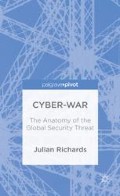Abstract
The conclusion reprises a three-tier categorisation of cyber warfare threats developed throughout the book. In the first tier are modern, cyber-enabled examples of traditional information operations which can happen both during conflict and in peacetime scenarios. In the second tier are cyber attack activities which enable and shape the prosecution of conflict in the physical realm. The third tier comprises those activities over which, it is argued, there is most scepticism at present: namely cyber attacks which cause real physical death and destruction. Predicting the future, however, is a risky business. For this reason, policymakers need to continue to model and plan for such contingencies, while not allowing them to pervert the overall assessment of cyber security priorities.
Access this chapter
Tax calculation will be finalised at checkout
Purchases are for personal use only
Preview
Unable to display preview. Download preview PDF.
Notes
D. Brown (2006) “A Proposal for an International Convention to Regulate the Use of Information Systems in Armed Conflict” Harvard International Law Journal 47/1, 179–221.
J.A. Lewis (2002) Assessing the Risks of Cyber Terrorism, Cyber War and Other Cyber Threats (Washington DC: Center for Strategic and International Studies (CSIS)).
S. Barnum (2013) Standardizing Cyber Threat Intelligence information with the Structured Threat Information expression (STIX) (Maclean VA: The Mitre Corporation), p. 3.
Author information
Authors and Affiliations
Copyright information
© 2014 Julian Richards
About this chapter
Cite this chapter
Richards, J. (2014). Conclusions: A Pathway through the Forest. In: Cyber-War: The Anatomy of the global Security Threat. Palgrave Pivot, London. https://doi.org/10.1057/9781137399625_6
Download citation
DOI: https://doi.org/10.1057/9781137399625_6
Publisher Name: Palgrave Pivot, London
Print ISBN: 978-1-349-48584-0
Online ISBN: 978-1-137-39962-5
eBook Packages: Palgrave Political Science CollectionPolitical Science and International Studies (R0)

